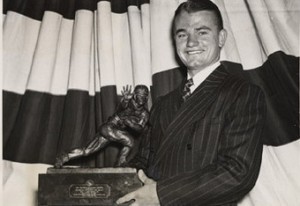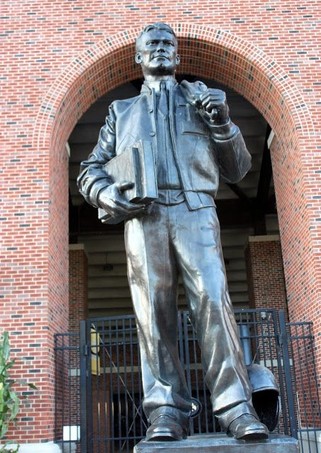Nile Kinnick
Introduction
Text-to-speech Audio
Images
Nile Kinnick being awarded the Heisman Trophy. “I'd like to make a comment which, in my mind, is indicative perhaps of the greater significance of football and sports emphasis in general in this country. And that is I thank God I was warring on the gridirons of the Midwest and not on the battlefields of Europe. I can speak confidently and positively that the players of this country would much more, much rather struggle and fight to win the Heisman award than the Croix de Guerre”

Nile Kinnick Statue in front of the main entrance into Kinnick Stadium. The statue is part of a tradition for the football team, as they touch the helmet walking into the stadium before a game.

Backstory and Context
Text-to-speech Audio
Nile Kinnick was born on July 9, 1918 in Adel, Iowa and was the grandson of the governor of Iowa. Kinnick was a known athlete throughout high school and knew he was going to play college sports. Kinnick had a tryout with the University of Minnesota but wasn’t offered to play for them and that led Kinnick to the University of Iowa (Flatter). His first two years playing at Iowa were uneventful as the football team went 1-7 his sophomore year and 1-6-1 his junior year with an ankle injury.
During his senior year, 1939, Kinnick led the Iowa football team to a 6-1-1 season. The Iowa football team were nicknamed the “Ironmen” and Kinnick was a main reason for this nickname as he scored 107 of the 130 points scored in the 1939 season (Flatter). At the end of the 1939 season, Kinnick was rewarded the Heisman Trophy, which goes to the most outstanding college football player of the year. Kinnick was the most nationally known player in college football and deserved to be rewarded the Heisman trophy. When awarded the trophy, Kinnick gave a speech that showed the type of person he is and showed that even athletes know there are things more important than football. The famous line from Kinnick’s speech, “I'd like to make a comment which, in my mind, is indicative perhaps of the greater significance of football and sports emphasis in general in this country. And that is I thank God I was warring on the gridirons of the Midwest and not on the battlefields of Europe. I can speak confidently and positively that the players of this country would much more, much rather struggle and fight to win the Heisman award than the Croix de Guerre” is just one reason that Kinnick is remembered in Iowa City (Howard, 2009).
After Kinnick’s football career at Iowa, he turned down a $10,000 offer from the Brooklyn Dodgers of the NFL and instead, Kinnick went into law school. Kinnick was only in law school for one year, deciding it was more important to fight for freedom and enlisting into the Naval Air Corps in 1941 during WWII (Flatter). In 1943 on June 2nd, Kinnick tragically died during a flight training mission. Off the coast of Venezuela, engine failure occurred. Kinnick decided to do an emergency landing into the Caribbean, and not endanger anyone on the U.S.S. Lexington. Kinnick’s body was never found after searching for hours, with only oil spots to be seen (Livingston, 2010). After these events Kinnick was inducted into the College Football Hall of Fame in 1951 and in 1962, Kinnicks head was put on the Big Ten coin as the heads side for the pregame coin flip.
There are two different ways Kinnick is commemorated in Iowa City and the first way is Kinnick Stadium, named after Nile Kinnick in 1972. When the war ended, the University of Iowa’s student council wanted to rename the football stadium after Kinnick, but his father didn’t want that as there were other men who had died in war and didn’t want his son to be the only soldier remembered. In 1972 is when they named the stadium Kinnick stadium after and when they got Kinnick’s fathers’ approval. In 2006, is when Kinnick’s statue was built in the main entrance of Kinnick Stadium standing 20 feet tall.
Sources
Howard, Spencer. Kinnick, Nile Clarke, The Biographical Dictionary of Iowa. University of Iowa Press, 2009. Accessed December 9th 2019. http://uipress.lib.uiowa.edu/bdi/DetailsPage.aspx?id=208.
Flatter, R. (n.d.). Everybody’s All-America. Retrieved from http://www.espn.com/classic/000802nilekinnick.html.
Livingston, B. (2010, November 20). Statue of Iowa legend Nile Kinnick a reminder of a long lost time in college sports: Bill Livingston. Retrieved from https://www.cleveland.com/livingston/2010/11/post_18.html
Schrader, G. (1957). Hawkeye Hall of Fame. The Palimpsest, 38(10), 427-436. http://tourtheten.com/iowa/traditions/game-day-traditions/nile-kinnick-statue/
